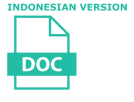Analisis Kebutuhan pada Pembelajaran Kolaboratif sebagai Strategi Pengajaran dalam Kelas Penerjemahan Bahasa Indonesia-Mandarin
Rika Limuria(1*)
(1) Universitas Kristen Maranatha
(*) Corresponding Author
Abstract
The translator’s profession has existed for decades and evolved as international interaction and communication intensified. The rising demand for the translator’s profession is met by undergraduate-level programs in foreign languages by providing translation classes. One of the challenges in undergraduate-level translation classes is the number of students and the inadequacy of students’ foreign language proficiency. The syllabus design of an undergraduate-level translation classroom has to consider several aspects, such as the number of students, students’ language proficiencies, and students’ needs. Translation class needs to train students in both, hard skills such as translation competence and content knowledge, and soft skills such as working under pressure and teamwork. Collaborative Learning (CL) could be an alternative to tackle this situation. In CL, learners are encouraged to collaborate to produce an acceptable translation. This study investigates the impact of Needs Analysis (NA) and Collaborative Learning (CL) in translation classrooms by surveying students of translation courses. Through NA, the trainer could understand learners’ needs before designing the syllabus. Besides that, CL benefits not only learners’ interpersonal skills but also learners’ translation skills.
Keywords
Full Text:
PDFReferences
Baker, M. (1992). In Other Words: A Coursebook on Translation. Routledge.
Barros, E. H. (2011). Collaborative learning in the translation classroom: Preliminary survey results. The Journal of Specialised Translation, 16, 42–60.
Bell, R. T. (1991). Translation and Translating: Theory and Practice. Longman Singapore.
Carreres, A. (2006). Strange Bedfellows: Translation and Language Teaching The teaching of translation into L2 in modern languages degrees; uses and limitations. Sixth Symposium on Translation, Terminology and Interpretation in Cuba and Canada, 1–24. https://www.academia.edu/27650215/Strange_Bedfellows_Translation_and_Language_teaching
Dewi, H. D., Pamungkas, M. E., & Hidayat, R. S. (2019). The 2006-2016 Translation Theory Development in Indonesian Universities: A Corpus-Based Study. Paradigma: Jurnal Kajian Budaya, 9(2), 140–153. https://doi.org/https://doi.org/10.17510/paradigma.v9i2.268
Hutchinson, T., & Waters, A. (1987). English for Specific Purposes: A Learner-Centered Approach. Cmabridge University Press.
Karnawati, R. A. (2018). Pengajaran Penerjemahan Cerita Bergambar Melalui Metode Word for Word Translation Sebagai Langkah Awal dalam Penerjemahan. Jurnal Bahasa Jepang Taiyou, 1(1), 45–64. https://doi.org/https://doi.org/10.22236/taiyou.v1i1.4827
Kelly, D. (2005). A Handbook for Translator Trainers. Routledge.
Kuntarto, N. M. (2017). Pengajaran Penerjemahan dalam Kelas Penulisan Akademis (Academic Writing) di Universitas Multimedia Nusantara. Nusa: Jurnal Ilmu Bahasa Dan Sastra, 12(1), 66–80. https://doi.org/https://doi.org/10.14710/nusa.12.1.66-80
Laviosa, S. (2014). Translation and Language Education Pedagogic Approaches Explored. Routledge.
Leeser, M. J. (2004). Learner proficiency and focus on form during collaborative dialogue. Language Teaching Research, 8(1), 55–81. https://doi.org/https://doi.org/10.1191/1362168804lr134oa
Long, M. H. (2005). Second Language Needs Analysis. Cambridge University Press. https://doi.org/https://doi.org/10.1017/CBO9780511667299
Richards, J. C. (2001). Curriculum Development in Language Teaching. Cambridge University Press. https://doi.org/https://doi.org/10.1017/CBO9780511667220
Rizal, S. S. (2017). Transkreasi puisi a Red Red Rose karya Robert Burns sebagai model penerjemahan kreatif karya sastra puisi dalam pengajaran kelas penerjemahan. JLT: Jurnal Linguistik Terapan, 7(1), 39–49. https://jurnal.polinema.ac.id/index.php/jlt/article/view/197
Smith, B. L., & MacGregor, J. T. (1992). What is Collaborative Learning? In A. Goodsell, M. Maher, V. Tinto, B. L. Smith, & J. MacGregor (Eds.), Collaborative Learning: A Sourcebook for Higher Education. National Center on Postsecondary Teaching, Learning, and Assessment (NCTLA). https://files.eric.ed.gov/fulltext/ED357705.pdf
Storch, N. (2011). Collaborative Writing in L2 Contexts: Processes, Outcomes, and Future Directions. Annual Review of Applied Linguistics, 31(March 2011), 275–288. https://doi.org/https://doi.org/10.1017/S0267190511000079
Yeni, T. U., & Ardi, H. (2021). Need Analysis of Text for Translation Material. Ninth International Conference on Language and Arts (ICLA 2020), Padang, West Sumatra, Indonesia.
Article Metrics
Refbacks
- There are currently no refbacks.
Copyright (c) 2023 The Author(s)

This work is licensed under a Creative Commons Attribution-ShareAlike 4.0 International License.







